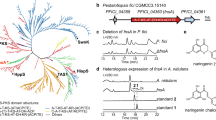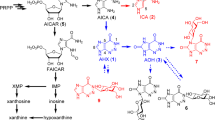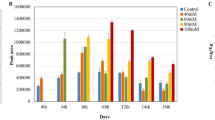Abstract
IT has been assumed generally, without adequate supporting evidence, that tryptophan and other indole compounds are generated via the shikimic acid pathway in higher plants. Evidence for this bio-synthetic pathway has been derived mainly from microbial studies and from theories based on the unity of biochemistry1–3. Proof that shikimic acid is a precursor to the aromatic amino-acids, phenyl-alanine and tyrosine, has been clearly obtained by McCalla and Neish4. It has also been demonstrated that higher plants possess a mechanism to convert quinic acid to shikimic acid and phenylalanine and tyrosine5–7. The latter aromatic acids are assumed to be derived from prephenic acid, which is transformed to phenylpyruvic and p-hydroxyphenyl-pyruvic acids, and afterwards to phenylalanine and tyrosine, respectively1. Since anthranilic acid, a precursor to tryptophan, may be derived from a separate branch of the aromatic pathway in microorganisms8, one might expect a similar situation to exist in higher plants as well. Recently, Wightman et al.9 have indeed reported that shikimate-U-14C gives rise to tryptophan and gramine in young barley seedlings in the light. Similar investigations on the conversion of quinate-U-14C and shikimate-U-14C to tryptophan in bean seedlings in the light and dark have been under investigation in this laboratory.
This is a preview of subscription content, access via your institution
Access options
Subscribe to this journal
Receive 51 print issues and online access
$199.00 per year
only $3.90 per issue
Buy this article
- Purchase on Springer Link
- Instant access to full article PDF
Prices may be subject to local taxes which are calculated during checkout
Similar content being viewed by others
References
Davis, B. D., Adv. Enzymol., 16, 247 (1955).
Davis, B. D., Arch. Biochem. Biophys., 78, 497 (1958).
Yanofsky, C., Bact. Revs., 24, 221 (1960).
McCalla, D. R., and Neish, A. C., Canad. J. Biochem. Physiol., 37, 531 (1959).
Weinstein, L. H., Porter, C. A., and Laurencot, jun., H. J., Nature, 183, 326 (1959).
Weinstein, L. H., Porter, C. A., and Laurencot, jun., H. J., Contrib. Boyce Thompson Inst., 20, 121 (1959).
Weinstein, L. H., Porter, C. A., and Laurencot, jun., H. J., Contrib. Boyce Thompson Inst., 21, 201 (1961).
Sprinson, D. B., Adv. Carbohydrate Chem., 15, 235 (1960).
Wightman, F., Chisholm, M. D., and Neish, A. C., Photochemistry, 1, 30 (1961).
Block, R. J., and Weiss, K. W., Amino Acid Handbook (Charles C. Thomas, Springfield, Ill., 1956).
Moore, S., Spackman, D. H., and Stein, W. H., Anal. Chem., 30, 1185 (1958).
Cartwright, R. A., Roberts, E. A. H., Flood, A. E., and Williams, A. H., Chem. and Indust., 1955, 1062 (1955).
Saslaw, L. D., and Waravdekar, V. S., Arch. Biochem. Biophys., 90, 245 (1960).
Author information
Authors and Affiliations
Rights and permissions
About this article
Cite this article
WEINSTEIN, L., PORTER, C. & LAURENCOT, H. Role of the Shikimic Acid Pathway in the Formation of Tryptophan in Higher Plants : Evidence for an Alternative Pathway in the Bean. Nature 194, 205–206 (1962). https://doi.org/10.1038/194205a0
Issue Date:
DOI: https://doi.org/10.1038/194205a0
This article is cited by
-
Overexpression of the salicylic acid binding protein 2 (SABP2) from tobacco enhances tolerance against Huanglongbing in transgenic citrus
Plant Cell Reports (2022)
-
Metabolite fingerprints of maize and sugarcane seedlings: searching for markers after inoculation with plant growth-promoting bacteria in humic acids
Chemical and Biological Technologies in Agriculture (2019)
-
Alicyclic acid metabolism in plants
The Botanical Magazine Tokyo (1974)
-
Zucker, Cyclite und organische S�uren des Cambialsaftes von Pinus silvestris L., Picea Abies Karst. und Abies alba Mill
Planta (1973)
-
Aromatic amino acid biosynthesis in Trichophyton rubrum III. Exogenous studies: Absence of the shikimic acid pathway
Mycopathologia et Mycologia Applicata (1970)
Comments
By submitting a comment you agree to abide by our Terms and Community Guidelines. If you find something abusive or that does not comply with our terms or guidelines please flag it as inappropriate.



